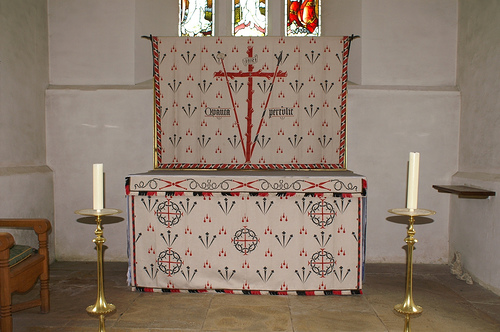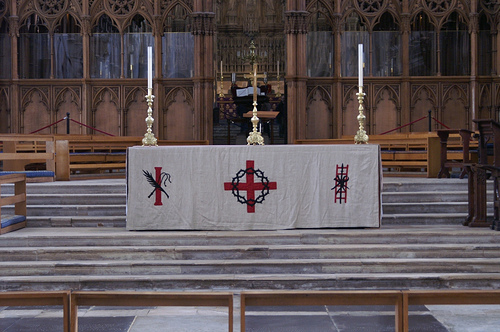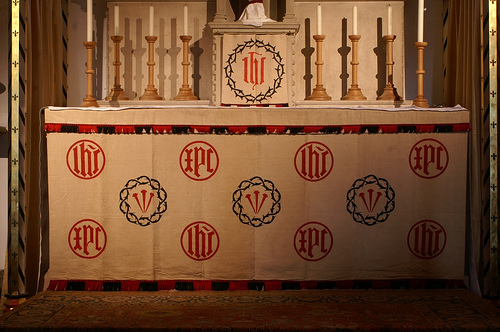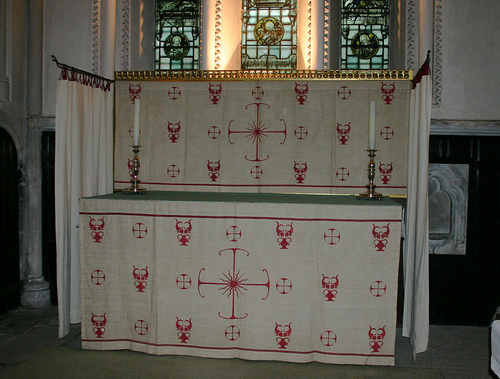Medieval History

Lenten array designed by F C Eden at North Cerney, Gloucestershire
So Lent is upon us once again. Until a few years ago it was fairly common to see the altars of English churches covered with unbleached linen hangings known as Lenten array. This striking custom is a medieval one and was fairly universal in medieval England.
In the Middle Ages the idea of covering altars, reredoses and images with off-white material, was to provide a visual deprivation of colour and ornament within the church building. The purpose of this was twofold. Firstly it was reflective of the contemplative character of the season. Thomas Becon, the protestant theologian, wrote about the purpose of it as he understood it:
'So likewise [in] this time of Lent, which is a time of mourning, all things that make to the adornment of the church are either laid aside or covered, to put us in remembrance that we ought now to lament and mourn for our souls dead in sin and continually to watch, fast pray, give alms etc. etc.'
Secondly the contrast between the visual deprivation of Lent, with the visual splendour of the festal hangings of Easter, emphasised the triumph of the resurrection.
In the Middle Ages the linen hangings were usually decorated with red, black or dark blue stencilled motifs. These motifs were generally related to the Passion of the Lord, the Instruments of the Passion or sacred monograms. The coverings over images were often stencilled or appliqued with an attribute, text or even by the late medieval period a representation of the image covered.

Lenten array on the nave altar at Winchester Cathedral.

Lenten array by the Warham Guild at St Birinus Dorchester, Oxfordshire.

Lenten array by Sir Ninian Comper in the retrochoir of Southwark Cathedral.
Additional reading
The best account of the medieval use of Lenten array, including a large amount of documentary evidence is probably W. St John Hope and E. G. C. Atchley English Liturgical Colours (London, 1918).
- Grantham Lent Array
At the glorious fourteenth century church of St Wulfram in Grantham, Lincolnshire is this dramatic example of Lenten array photographed here by SarumSleuth. The array entirely coveres George Gilbert Scott's magnificent towering reredos....
- Lenten Array 2011
The ancient western custom of covering altars and images with Lenten array and Lenten veils has been covered on this blog a number of times. If you want to know more about the custom and its purpose look at the article here and...
- Lenten Array ... One That Got Away
Fairford Gloucestershire, originally uploaded by Vitrearum (Allan Barton).I fully intended to post this photograph during Lent. The Lady altar in the Tame chapel at Fairford in Gloucestershire has a reredos of 1913 by Geoffrey Webb, covered during Lent...
- It's That Time Of Year Again, Time To Put Up The Lenten Array!
The Lenten array at All Saints, Cuddesdon in Oxfordshire, all three altars draped in unbleached linen with blood red decoration. The stencilled shields containing instruments of the Passion, are from the Lenten array frontal at St Mary's...
- North Cerney, Gloucestershire - Part 1
If I was a country parson living in, dare I say it, the good-old-days of the Church of England, when there was one priest per parish. The one parish I would love to serve would be North Cerney in the Cotswolds near Cirencester. In my mind the church in...
Medieval History
Lenten array

Lenten array designed by F C Eden at North Cerney, Gloucestershire
So Lent is upon us once again. Until a few years ago it was fairly common to see the altars of English churches covered with unbleached linen hangings known as Lenten array. This striking custom is a medieval one and was fairly universal in medieval England.
In the Middle Ages the idea of covering altars, reredoses and images with off-white material, was to provide a visual deprivation of colour and ornament within the church building. The purpose of this was twofold. Firstly it was reflective of the contemplative character of the season. Thomas Becon, the protestant theologian, wrote about the purpose of it as he understood it:
'So likewise [in] this time of Lent, which is a time of mourning, all things that make to the adornment of the church are either laid aside or covered, to put us in remembrance that we ought now to lament and mourn for our souls dead in sin and continually to watch, fast pray, give alms etc. etc.'
Secondly the contrast between the visual deprivation of Lent, with the visual splendour of the festal hangings of Easter, emphasised the triumph of the resurrection.
In the Middle Ages the linen hangings were usually decorated with red, black or dark blue stencilled motifs. These motifs were generally related to the Passion of the Lord, the Instruments of the Passion or sacred monograms. The coverings over images were often stencilled or appliqued with an attribute, text or even by the late medieval period a representation of the image covered.

Lenten array on the nave altar at Winchester Cathedral.

Lenten array by the Warham Guild at St Birinus Dorchester, Oxfordshire.

Lenten array by Sir Ninian Comper in the retrochoir of Southwark Cathedral.
Additional reading
The best account of the medieval use of Lenten array, including a large amount of documentary evidence is probably W. St John Hope and E. G. C. Atchley English Liturgical Colours (London, 1918).
- Grantham Lent Array
At the glorious fourteenth century church of St Wulfram in Grantham, Lincolnshire is this dramatic example of Lenten array photographed here by SarumSleuth. The array entirely coveres George Gilbert Scott's magnificent towering reredos....
- Lenten Array 2011
The ancient western custom of covering altars and images with Lenten array and Lenten veils has been covered on this blog a number of times. If you want to know more about the custom and its purpose look at the article here and...
- Lenten Array ... One That Got Away
Fairford Gloucestershire, originally uploaded by Vitrearum (Allan Barton).I fully intended to post this photograph during Lent. The Lady altar in the Tame chapel at Fairford in Gloucestershire has a reredos of 1913 by Geoffrey Webb, covered during Lent...
- It's That Time Of Year Again, Time To Put Up The Lenten Array!
The Lenten array at All Saints, Cuddesdon in Oxfordshire, all three altars draped in unbleached linen with blood red decoration. The stencilled shields containing instruments of the Passion, are from the Lenten array frontal at St Mary's...
- North Cerney, Gloucestershire - Part 1
If I was a country parson living in, dare I say it, the good-old-days of the Church of England, when there was one priest per parish. The one parish I would love to serve would be North Cerney in the Cotswolds near Cirencester. In my mind the church in...
